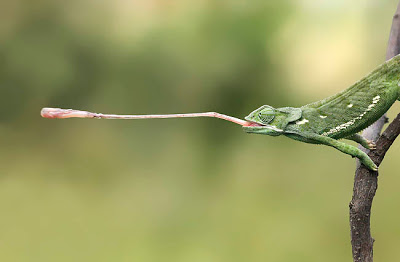Feeding Your Pet Chameleon (Chameleon Nutrition Basics)
For those of you looking to become first-time chameleon owners, there is a lot of information that you need to absorb. While chameleons are one of the most fantastic pets on the market, their care is a challenge even for experts. This article is going to discuss feeding since it's a subject that seems to confuse many first-time owners.
Let's start with the most commonly asked question concerning chameleon feeding. What do chameleons prefer to eat?

Chameleon's seem to prefer crickets but a variety is the key to raising a healthy chameleon. They love to eat a wide range of different bugs. Consider how a chameleon living in the wild eats. It sits in a spot and catches whatever insects fly or crawl near it. You can imagine that it gets a wide variety of food. Since you need to simulate nature as best you can, then you should offer your chameleon a wide range of insects.
What's on the Chameleon Menu?
Again, a chameleon must be given a wide variety of insects. Chameleons gain more nutritional value by consuming many different insects as opposed to only eating crickets. Plus they will actually go on a hunger strike if given the same food day after day. With that said, here is a quick look at the favorite foods of a chameleon.
Crickets: The most common food for chameleons are crickets. Plus crickets are also easy to gut feed, a technique that is explained in the "Chameleon Care Guide – Keeping & Breeding Healthy Chameleons Made Easy".
Grasshoppers: Grasshoppers are another common food choice for chameleons. They also offer more nutritional value than crickets. However, the downside is that grasshoppers are often difficult to find.
Flies: Chameleons often eat these in the wild so they deserve a mention here. As you might have guessed though, they are difficult for captive chameleons to catch. You're probably better off visiting the fish section of your local pet shop and buying dried flies.
Hornworms: The two different types of hornworms are named respectively after the plants they consume. You can purchase and grow them. Hornworms will eventually become hawk moths. Some owners choose to allow this transformation to occur and then release the moth into their chameleon's habitat.
Silkworms: This is a highly recommended addition to a chameleon's diet. You can buy them as eggs and raise these worms yourself. Once they get nice and large, feed them to your chameleon. Silkworms will also transform into moths.
Waxworms: Most pet shops sell waxworms since they can be fed to many different types of pets. It's worth noting that waxworms do not offer nutritional value to your chameleon. Think of them like a treat.
Mealworms: These worms will eventually transform into beetles. Larger versions of this worm can bite you so be extra careful when handling them. This worm can be gut fed to provide even more nutritional value to your lizard.
Cockroaches: Cockroaches are easy to purchase since most pet shops stock them. Try and find the specimen of cockroach that cannot climb glass walls. They breed quickly so you can farm an endless supply for your lizard. Finally, they easy to gut load.
I have given you a wide variety of food choices for your chameleon. Although a chameleon can consume more than the ones listed above, I recommend that you stick with the menu. First, you can only handle so many insects at the time so adding more will become overwhelming. Secondly, these insects will provide both a healthy variety and offer nutritional value to your chameleon. To be honest, you would be okay to just use half of the insects listed above.
Check out the "Chameleon Care Guide" to find out about:
- A detailed breakdown of how the day-to-day menu should be.
- What you should NEVER feed your chameleon!
- How much should you be feeding your chameleon?
- What "Gut Loading" is and how to do it (and why it is important).
- What to do if your chameleon goes on hunger strike…
- And much, much more…

|